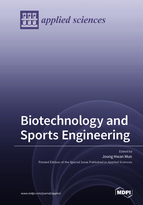Biotechnology and Sports Engineering
A special issue of Applied Sciences (ISSN 2076-3417). This special issue belongs to the section "Applied Biosciences and Bioengineering".
Deadline for manuscript submissions: closed (30 April 2021) | Viewed by 43348
Special Issue Editor
Interests: embedded systems in health care; artificial intelligence in medical devices; Internet of Things for medial devices; wearable sensors for human motion
Special Issues, Collections and Topics in MDPI journals
Special Issue Information
Dear Colleagues,
The International Conference on Biotechnology and Sports Engineering (ICON-BASE 2021) will be held in Hwaseong, South Korea, 23-25 April 2021. We are pleased to announce our agreement with Applied Sciences to publish a Special Issue on ICON-BASE 2021 and cordially invite selected participants to submit a full-length manuscript of their work presented in ICON-BASE 2021 for publication on this Special Issue of Applied Sciences (ISSN 2076-3417; Impact Factor = 2.474 (2019); mdpi.com/journal/applsci). The APC payment will be processed through the International Conference on Biotechnology and Sports Engineering (ICON-BASE 2021) for the authors who participated in ICON-BASE 2021.
Topics of interest include but are not limited to:
Biotechnology:
- Biomechanics
- Neural control of movement
- Human locomotion
- Computational biomechanics
- Fluid biomechanics
- Biomedical visualization
- Computer-aided surgery
- Medical robotics
- Biosensors
- Implant design
- Biomedical instrumentation
- 3D Printing
Sports Engineering:
- Exercise rehabilitation
- Life fitness assessment
- Exercise training
- Sports mechanics
- Sports medicine
- Clinical biomechanics
- IoT sensor technology in sports
- Clinical exercise physiology
- Public health
- Metabolism
- Nutrition
- Neural control of movement
Prof. Dr. Joung Hwan Mun
Guest Editor
Manuscript Submission Information
Manuscripts should be submitted online at www.mdpi.com by registering and logging in to this website. Once you are registered, click here to go to the submission form. Manuscripts can be submitted until the deadline. All submissions that pass pre-check are peer-reviewed. Accepted papers will be published continuously in the journal (as soon as accepted) and will be listed together on the special issue website. Research articles, review articles as well as short communications are invited. For planned papers, a title and short abstract (about 100 words) can be sent to the Editorial Office for announcement on this website.
Submitted manuscripts should not have been published previously, nor be under consideration for publication elsewhere (except conference proceedings papers). All manuscripts are thoroughly refereed through a single-blind peer-review process. A guide for authors and other relevant information for submission of manuscripts is available on the Instructions for Authors page. Applied Sciences is an international peer-reviewed open access semimonthly journal published by MDPI.
Please visit the Instructions for Authors page before submitting a manuscript. The Article Processing Charge (APC) for publication in this open access journal is 2400 CHF (Swiss Francs). Submitted papers should be well formatted and use good English. Authors may use MDPI's English editing service prior to publication or during author revisions.
Keywords
- biomechanics
- biomedical instrumentation
- biosensors
- sports medicine
- exercise rehabilitation
- public health






